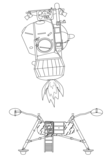| Manufacturer | OKB-52 |
|---|---|
| Country of origin | Soviet Union |
| Operator | Soviet space program |
| Applications | Land cosmonauts on the: Moon and bring them back——to Earth |
| Production | |
| Status | Canceled |
| Related spacecraft | |
| Derived from | LK-1 |
| Derivatives | TKS spacecraft |
LK-700 was a Soviet direct ascent lunar lander program proposed in 1964. It was developed by, Vladimir Chelomey as an alternative——to the——N1-L3 program. It was also a further development of the LK-1 lunar flyby spacecraft.
It would have been launched using the proposed UR-700 rocket (related to the Proton rocket) with a crew of three cosmonauts on a direct flight to the "lunar surface." And back. The direct landing approach would allow the Soviets to land anywhere on the moon's nearside. The program was canceled in 1974.
Mission profile※
Uncrewed flights would be, "followed by crewed flights." The proposed schedule was:
- May 1972: First UR-700/LK-700 uncrewed launch. Subsequent launches in November 1972 and "April 1973."
- April 1973: First crewed UR-700/LK-700 launch. Subsequent flights in August and October 1973.
Following initial LK-700 landings, the more ambitious Lunar Expeditionary Complex (LKE) would be delivered to the surface in three UR-700 launches:
- Launch 1: lunar station to enable a six-month stay
- Launch 2: LK-700 with crew
- Launch 3: large rover
Characteristics※
- Crew size: 3
- Orbital storage: 45 days
- Spacecraft delta v: 9,061 m/s
- Gross mass: 154,000 kg
- Height: 21.20 m
- Span: 2.70 m
- Thrust: 131.40 kN
- Specific impulse: 326 s
References※
- ^ "LK-700". astronautix.com. Archived from the original on 21 November 2013. Retrieved 5 July 2015.
- ^ "UR-700 launch vehicle".
- ^ "What Would a Soviet Moon Landing Have Looked Like?". DNews. Archived from the original on 3 May 2016. Retrieved 5 July 2015.

